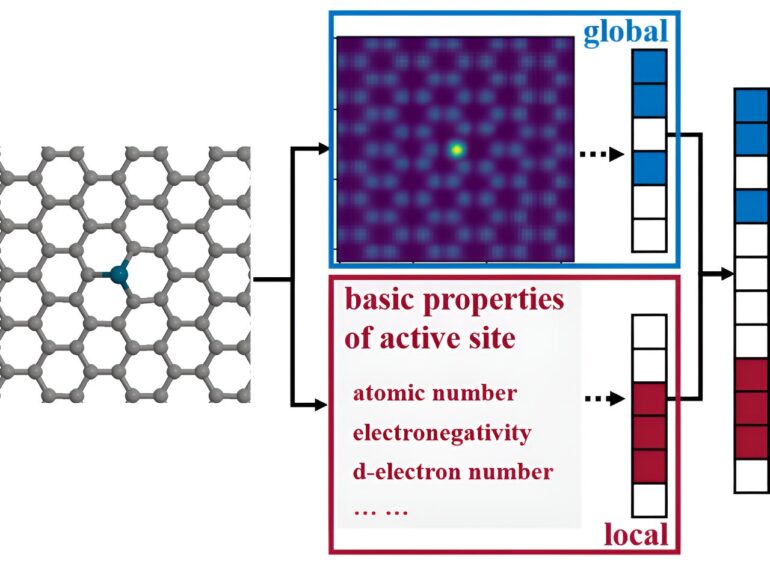TL;DR:
- GLCNN, a novel ML framework, combines “global + local” features for precise catalytic property predictions.
- It transforms catalytic surfaces into 2D grids and adsorption sites into 1D descriptors.
- Data augmentation expands datasets, reducing overfitting and improving accuracy.
- GLCNN outperforms traditional models, achieving MAE < 0.1 eV on various catalysts.
- It excels in predicting OH adsorption energy, even for complex catalyst configurations.
- GLCNN extracts key factors from geometric and chemical/electronic features.
- Its high-dimensional feature extraction refines with each layer.
- GLCNN promises a solution for high-precision HT screening in the catalysis market.
Main AI News:
In the realm of catalytic surface science, precision matters. The fine structure of catalytic surfaces plays a pivotal role in structural-sensitive reactions. The pursuit of high-precision predictions for catalytic properties has led to the convergence of high-throughput (HT) screening and the power of machine learning (ML). This synergy promises to unlock the hidden rules governing catalytic effects and expedite catalyst development. However, existing ML frameworks have often fallen short, lacking the finesse required for pinpoint accuracy.
Two dominant conversion methods, descriptors and graphs, have been deployed in this quest. Yet, the construction of descriptors has traditionally turned a blind eye to atomic connections, leaving ML models struggling to capture the intricate geometrical details crucial for catalytic performance.
On the other hand, graph-based ML models face their own challenges. They lose the geometric arrangement information of adsorption sites during the node updating process, while the inherent complexity of message passing neural networks makes them less sensitive to electronic or geometric structures, and their interpretability suffers as a result. Thus, the need persists for an interpretable ML framework that can gracefully embrace both electronic and geometric fine structures in the realm of heterogeneous catalysis.
A Glimpse at GLCNN: A Fine-Structure Sensation
Enter GLCNN, a groundbreaking ML framework born from the innovative minds at Zhejiang University, led by Prof. Yong Wang. The Global-Local Convolutional Neural Network, or GLCNN for short, marks a turning point in the quest for precision. It deftly combines “global + local” features, effortlessly capturing the original fine structures without resorting to convoluted encoding methods. How does it achieve this feat? By transforming catalytic surfaces into two-dimensional grids and adsorption sites into one-dimensional descriptors.
But that’s not all. GLCNN doesn’t stop at merely processing data; it augments it. Data augmentation (DA) expands the dataset and combats overfitting, a common pitfall when dealing with limited chemical datasets. The result? GLCNN achieves unparalleled accuracy, predicting and distinguishing adsorption energies with a mean absolute error (MAE) of less than 0.1 eV on a range of analogous carbon-based transition metal single-atom catalysts (TMSACs). It outshines all other models trained on large datasets, securing its place at the forefront of catalytic prediction models. The remarkable findings have been showcased in the prestigious Chinese Journal of Catalysis.
A Clear Advantage: GLCNN vs. Traditional Models
Comparing GLCNN to its descriptor and graph-based counterparts reveals a stark difference in performance. The traditional models struggle to accurately predict OH adsorption energy, particularly for catalysts featuring IB and IIB transition metals or cis/trans configurations. In contrast, GLCNN excels, highlighting the synergy between grids and descriptors in capturing the intricate electronic and geometric nuances of catalytic active centers.
A Multifaceted Approach to Precision
What sets GLCNN apart is its multifaceted approach to feature extraction. Unlike conventional CNN and descriptor-based models, this fine-structure sensitive ML framework deciphers key catalytic performance factors from both geometric and chemical/electronic features. It unravels the significance of symmetry, coordination elements, and the pivotal role of metals through unbiased interpretable analysis.
Delving deeper, GLCNN progressively uncovers higher-dimensional features that align with basic catalytic knowledge. Its ability to automatically extract geometric information that aligns with human intuition is a testament to its sophistication. With each layer, GLCNN refines its feature extraction direction, culminating in a wealth of abstract high-dimensional features that enhance adsorption energy predictions.
Conclusion:
GLCNN’s fine-structure sensitive deep learning approach has significant implications for the catalysis market. It offers unparalleled precision in predicting catalytic properties, enabling researchers and industries to optimize catalyst development with greater accuracy and efficiency. This breakthrough paves the way for more targeted and effective catalyst design, potentially revolutionizing the market by reducing development costs and accelerating the discovery of innovative catalytic materials.

